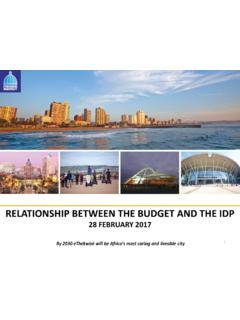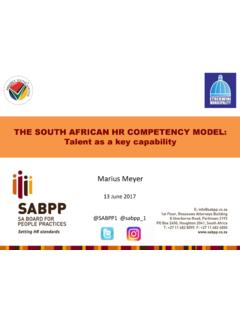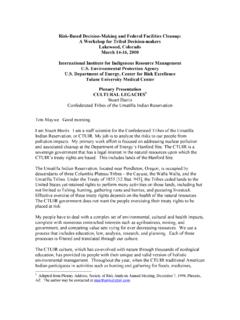Transcription of Localizing and Mainstreaming Sustainable …
1 Sustainable development goals (SDGs) Localizing and Mainstreaming Sustainable development goals : An Inclusive Implementation Process BACKGROUND FRAMEWORK APPROACH ROADMAP DOMESTICATION SDG BACKGROUND GLOBAL 25 September 2015, a set of 17 goals and 230 indicators adopted to provide a framework for global development The MDGs represented a commitment to a global agenda to reduce poverty, measured through 8 time-bound targets The SDGs serve as a platform to continue monitoring development and reporting post-2015 Weak institutional framework no monitoring, accountability and legitimacy (addressing targets not achieved) Implementation and reporting framework reporting should not be a frame for implementation Disconnection between government and civil society limited constructive debate and meaningful policy influence Translating technical to tangible translating goals into action at the lowest levels Data gaps geographically disaggregated data and quality assured data goals achieved / goals deferred - politics of data turning real successes into reported failures and real failures into reported successes MDG lessons learned SDG FRAMEWORK GLOBAL SDGs main aim is to end poverty + integrate the 3 dimensions of Sustainable development Protect our ecosystems for all societies and our children 2 1 To grow a strong, inclusive and transformative economy Each goal should be analysed and pursued with regard to the three dimensions 3 To end poverty.
2 Inequality Protect our ecosystems for all societies and our children 1 2 3 To end poverty, inequality To grow a strong, inclusive and transformative economy Ensure healthy lives, knowledge and the inclusion of woman and children Promote safe and peaceful societies and strong institutions 1 To grow a strong, inclusive and transformative economy Promote safe and peaceful societies and strong institutions Ensure healthy lives, knowledge and the inclusion of woman and children Protect our ecosystems for all societies and our children 2 3 To end poverty, inequality Goal 1 End poverty Goal 2 End hunger, achieve food security Goal 3 Ensure healthy lives Goal 6 Ensure available & Sustainable water Goal 4 Ensure equitable quality education Goal 10 Reduce inequality Goal 5 Achieve gender equality Goal 6 Promote peaceful & inclusive societies Goal 8 Promote inclusive economic growth Goal 7 Ensure affordable & Sustainable energy Goal 9 Build resilient infrastructure Goal 12 Ensure Sustainable consumption and production Goal 14 Conserve and sustainably use the oceans Goal 13 Strengthen implementation Goal 15 Protect, restore and promote terrestrial ecosystems Goal 11 Make cities inclusive, safe, resilient and Sustainable Goal 13 Urgent action to combat climate change 1 2 3 SDG APPROACH GLOBAL Apply to every nation, every sector.
3 Every organization Are inter-connected in a system for inclusiveness and coherence Are about changing how we do things The approach of the SDGs agenda is a departure from the MDG process in 3 important ways Apply to every nation, every sector, every organization Are inter-connected in a system for inclusiveness and coherence Are about changing how we do things Significant changes: zero goals , universal goals , comprehensive goals , but also .. Are based on better data: timely, disaggregated, reliable information systems monitoring, evaluation and accountability Data are not just about measuring changes, they also facilitate and catalyse that change The data revolution refers to opportunity to improve the data for decision-making, accountability and solving development challenges. Data are the lifeblood of decision-making and the raw material for accountability.
4 A vibrant data driven ecosystem Enable data to play its full role in the realisation of Sustainable development by closing key gaps GLOBAL to LOCAL DOMESTICATION How does South Africa balance ambition and realism in setting National targets for the SDGs? How realistic are the targets within the context of the South Africa s capacity and commitment? How do we ensure that targets and indicators reflect local and national peculiarities? What are the factors that affect each target or indicator at the national or local levels? How does SA report progress locally as opposed to being on track globally? Mainstreaming SDG Mainstreaming refers to the incorporation of Sustainable development targets in national and local strategies, plans, and budgets, and data systems To meaningfully act toward their achievement of the goals requires a process to take into account different local realities, capacities and levels of development , linking and respecting relevant processes, policies and priorities AU VISION 2063 CONTINENTAL A strategic framework for the socio-economic transformation of the continent over the next 50 years for growth and Sustainable development .
5 An integrated, prosperous and peaceful Africa, driven by its own citizens and representing a dynamic force in International arena A set of 20 goals identified based on the AU Vision, 7 African aspirations PGDS FRAMEWORK LOCAL In 2012 the, PGDS and PGDP were adopted - a set of 7 goals translated into 31 strategic objectives to provide a framework for provincial development By 2035 KwaZulu-Natal will be a prosperous Province with a healthy, secure and skilled population, living in dignity and harmony, acting as a gateway to Africa and the World 1 GOAL INCLUSIVE ECONOMIC GROWTH 3 GOAL HUMAN AND COMMUNITY development 5 GOAL ENVIRONMENTAL SUSTAINABILITY 4 GOAL STRATEGIC INFRASTRUCTURE 2 GOAL HUMAN RESOURCE development STRATEGIC goals KwaZulu-Natal will be a prosperous Province with a healthy, secure and skilled population, living in dignity and harmony, acting as a gateway to Africa and the World 6 GOAL GOVERNANCE AND POLICY 7 GOAL SPATIAL EQUITY 3 GOAL STRATEGIC goals Enhance health of communities and citizens Poverty eradication and social welfare Enhance Sustainable household food security Sustainable human settlements Safety and security Advance youth, gender and disabled Advance social capital HUMAN AND COMMUNITY development Domestication 3 Multi-stakeholder 2 Monitoring Reporting 6 Policy coherence 4 Public awareness 1 Budgeting 5 Risk Adaptability 7 SHORT TERM LONG TERM S D G s Mainstreaming tailoring SDGs to national, sub-national and local contexts We do not implement the SDGs.
6 We implement programmes to achieve the them Stats SA is the national coordinator of the SDG reporting process, culminating in the production of the country report on progress toward achieving the goals reporting without the context of we cannot talk about implementing Sustainable development goals (SDGs) Localizing and Mainstreaming Sustainable development goals : An Inclusive Implementation Process SDG PROCESS ROADMAP DOMESTICATION IMPLEMENTATION Legislature oversight Parliament oversight Monitor, Communicate review system that promotes systemic understanding Align, Localise a process of domestication to contextualise Data, reporting a system for advocacy capacity building Legislature oversight Parliament oversight Monitor, Communicate review system that promotes systemic understanding Align, Localise a process of domestication to contextualise Data, reporting a system for advocacy capacity building What existing structure / fora can be used?
7 ? Define roles of provincial role and respons Define priorities What is the ideal structure for KZN?? Engage continuously Stats SA Responsibility Shared Responsibility SDG PROCESS LOCAL generate sustained public awareness, involvement, support, ownership and accountability engage national, provincial and local government, civil society, businesses, community based groups, academia translate global to local: relevant, applicable and attainable at national, provincial and local levels / Public awareness 1 Multi-stakeholder 2 Domestication 3 A report FOR the countries stakeholders, developed BY the countries stakeholders Emphasising the principle of Leaving no one behind Satisfying SA/KZN Developmental Needs Domestication 3 Multi-stakeholder 2 Public awareness 1 Align, Localise a process of domestication to contextualise and adjusted to meet local peculiarities Public awareness 1 generate sustained public awareness, involvement, support, ownership and accountability Multi-stakeholder 2 engage national, provincial and local government, civil society, businesses, community based groups.
8 Academia KZN SDG Process SDG advocacy and promotion provincially and regionally - Various stakeholders involved in process Technical and regional workshops attended by various stakeholders from Gov, CSOs, Academia, Parastatals, Business, development Partners 75 additional domesticated indicators emanated from the Technical and regional workshops translate global to local: relevant, applicable and attainable at national, provincial and local levels / Domestication 3 Key issues emanating Meaningful collaboration with Civil Society structures IDP public participation., legislature civil society engagement Engagement with business and development of public-private partnerships Mobilizing public awareness through existing channels There are 230 indicators which are technical in nature, this can be complex to engage meaningfully, especially as the goals should not be viewed in isolation Limited knowledge and exposure to government planning frameworks and processes Institutionalizing collaboration with existing provincial government structures to define a provincial governance structure for the SDG process Monitoring Reporting 6 Data, reporting a system for advocacy capacity building = platform to serve implementation Without high-quality data providing right information on the right things at the right time.
9 Designing, monitoring and evaluating effective policies becomes almost impossible Monitoring Reporting 6 a data ecosystem to provide timely, disaggregated data and reliable information systems for accountability 230 indicators divided into 3 Tiers to be monitored: Tier 1: Clear standards and methods developed and data available on the indicators Tier 2: Clear standards and methods developed, but not all countries have data on the indicator (data available in < 50% of countries) Tier 3: No standards and methods exist or methods are in process of being developed KZN SDG Process SDG 144 - goals 1; 3 5; 10 - Goal 2 and partnerships - goals 7 9 and 17 - goals 6; 11 - 15 , Safety and Governance - Goal 16 National Coordinating Committee (NCC) National Sectoral working groups (SWG) Roles and responsibilities: Domesticate Identify additional indicator data sources Assemble metadata Review and revise goal reports Methodology, technical and data issues Staffed with technical people, representatives from: Stats SA, Sector Departments, Private Sector, International organisations CSO Data and Reporting framework The implementation and refinement of the PGDP has been institutionalised through the system or structure of Action Work Groups (AWGs), 17 set up to take responsibility for the implementation and reporting of the various Strategic Objectives of the PGDP, as well as to provide input to the annual refinement of the PGDP.
10 The SDG process to be aligned to this institutional framework PGDP and Action working groups Data and Reporting framework (Proposal) - Provincial Theme AWG PGDP Goal SDG Goal People 8 & 17 3 & 6 5, 10, 16 Poverty, Food Security and Inequality 8 3 1 & 2 Health 10 3 3 Education 6 & 7 2 4 Labour 1 - 5 1 1 Economy 1 5, 12 & 13 1 & 4 3 & 9 Households 9, 11 & 18 3 & 7 11 Water & Sanitation 14 4 6 Energy 15 4 & 5 7 Environment 16 4 & 5 12 - 14 Governance 17 6 15 & 16 75 additional domesticated and supplementary indicators were proposed for all the 17 goals Additions submitted to National on 16 November 2016 Domesticated indicators and Supplementary and proxy indicators Goal 8 Key issues emanating - Planning alignment and the SDG as a process While the alignment of the SDGs to the local priorities are clear, there seem to be fragmentation in terms of the strategy.










